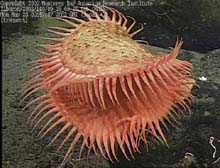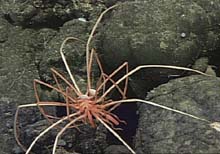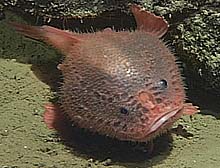
The exploration team took this picture of a flytrap anemone at Davidson Seamount. Click image for larger view.
Role of Sanctuary in Davidson Seamount Expedition
May 19, 2002
William J. Douros, Superintendent
Monterey Bay National Marine Sanctuary
The Monterey Bay National Marine Sanctuary protects a remarkable region of central California's coastal ecosystem, with incredible biological diversity and geologic features. But there are other incredible geologic and biological features along the coast outside of the Sanctuary. Perhaps the most striking of these is the Davidson Seamount, about 20 miles west of the Sanctuary, along the Big Sur coast.
What makes the Davidson Seamount so enticing for exploration is that it is a gigantic, submerged volcano, rising a striking 7,250 feet above the sea floor. If it were on land, the Davidson Seamount would dominate the landscape like Mount Shasta dominates the horizon throughout Northern California. Its length and width - 30 miles long and 12 miles wide - could fill Monterey Bay from the Santa Cruz boardwalk to Monterey's Fishermen's Wharf.
Despite its size, the top of the Davidson Seamount is still 4,500 feet below the ocean's surface. This means typical human activities probably have not yet harmed the seabed and organisms growing on it. Anchoring and trawling usually don't occur below 1,500 feet, and near shore discharges and disposal occur far away, along the coastline.

The exploration team took this picture of a sea spider molting at Davidson Seamount. Click image for larger view.
The seclusion from human impacts was a major motivation in the Sanctuary's developing this mission to explore the Davidson Seamount. Just prior to this mission, Sanctuary scientists and our collaborators had planned to evaluate seafloor effects from trawling within the Sanctuary. That mission, which was planned as part of Sanctuary Quest 2002, was cancelled after a fire aboard NOAA's research vessel McArthur.
We had hoped to compare the seafloor at the Davidson Seamount to that which we find inside the Sanctuary, where trawling and other seafloor impacts occur. Nonetheless, an exploration of the Davidson Seamount will still give us an idea, on a relative scale, about the health of the habitat and the harm humans can cause.
Offshore seamounts can be aggregation areas for marine mammals and seabirds due to localized “upwelling”. On our cruise to the Davidson Seamount, we are assessing the presence and absence, as well as abundance, of these species.
All of this will give scientists and sanctuary management an indication of the biological importance of the Davidson Seamount relative to the Monterey Bay National Marine Sanctuary. We'll also get insight as to whether the habitats and populations at the Davidson Seamount could be harmed by human activities.

The exploration team took this picture of an unidentified frogfish at Davidson Seamount. Click image for larger view.
The National Marine Sanctuaries Program has begun a multi-year, joint effort to review and update the management plans for the Monterey Bay, Gulf of Farallones, and Cordell Bank National Marine Sanctuaries. Initial public comments have asked NOAA to consider adding the Davidson Seamount to the Monterey Bay National Marine Sanctuary. We also heard suggestions to protect the Davidson Seamount, as well as the Guide, Gumdrop, and Pioneer Seamounts just to the north, as a new National Marine Sanctuary or extension of the Monterey Bay National Marine Sanctuary.
This mission, and the video and data products we are collecting, will be critical in our evaluation of these proposed management strategies. It's an exciting time to be working on ocean issues in central California and this mission adds to that excitement.
Sign up for the Ocean Explorer E-mail Update List.















